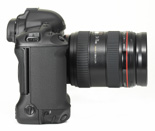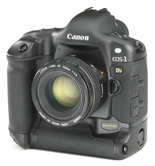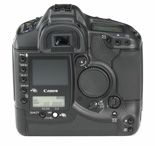
Sito italiano sulla natura e fotografia naturalistica
Copyright ©2001 ARDEA riproduzione vietata, tutti i diritti della legge sui diritti d'autore
![]()

Sito italiano sulla natura e fotografia naturalistica Copyright ©2001 ARDEA riproduzione vietata, tutti i diritti della legge sui diritti d'autore
|
|
EOS 1Ds |
|
 |
 |
 |
Canon introduces the world's first full-frame professional digital camera with an 11.1 megapixel CMOS sensor
Canon's latest professional digital camera is based on the EOS 1D, but targets studio photographers. The EOS 1Ds (the 's' is for 'studio') features an 11.1 megapixel CMOS sensor, offering a resolution nearly three times that of the EOS 1D.
The new camera is an addition to the range, rather than a replacement. The EOS 1D, with its continuous shooting speed of 8 frames per second, will still be a favourite for news and sports photographers. The EOS 1Ds shooting speed of 3 frames a second is more suited to the world of portrait and pack shot photography.
Another major benefit of the EOS 1Ds is its full-frame sensor. For all practical purposes, the 35.8 x 23.8mm sensor is the same size as a 35mm film frame (nominally 36 x 24mm). This means that EF lenses on the new camera show the same angle-of-view seen on EOS analogue (film) models a feature which will be welcomed by ultra-wide-angle lens users.
With image quality close to that of film, the EOS 1Ds is likely to accelerate the transition from film to digital among professional users.
CMOS sensor
The EOS 1Ds has made a huge leap in resolution. Until now, the EOS D60 was the Canon camera which offered the highest resolution, with a 6 megapixel CMOS sensor. This was followed by the EOS 1D with a 4.3 megapixel CCD sensor.
It is Canon's continuing development of CMOS technologies which has produced the 11.1 megapixel full-frame sensor. The high noise-to-signal ratio which has limited the use of CMOS sensors in digital cameras has been overcome. The newly-developed single plate sensor produces little noise and the signal-reading system has been changed to suppress this noise to an insignificant level, even at the equivalent of ISO 1250.
A new imaging engine has been introduced. This has been designed to produce high image quality, excellent colour reproduction and a wide tonal range equal to, or better than, professional 35mm slide film.
The JPEG image processing parameters (tone curve, sharpness and quality) can now be set with the camera (previously these could only be adjusted when a camera was connected to a computer).
Since CMOS sensors consume less power than CCDs, battery life has been improved over the EOS 1D.
Increased FAT
Until now, digital cameras have used the FAT 16 media format. This can only handle recording media up to 2GB. If you use a recording medium with more than 2GB storage, you will be limited to 2GB. FAT 32 is a media format introduced after Windows 98 and can handle up to 2048GB of storage (though no storage cards of this capacity are yet available). The EOS 1Ds offers automatic setting of FAT 16 or 32. The camera detects the storage capacity of card loaded and chooses the appropriate format.
The EOS 1Ds has a single card slot which accepts Type I and Type II CompactFlash cards and IBM Microdrives.
High technology
The high-speed FireWire (IEEE1394) standard enables 50Mbps throughput for high transfer speeds with rapid plug and play downloads to a computer.
A range of white balance settings cover most common lighting types, but the colour temperature can also be set manually between the range 2800 and 10000 K. White balance exposure bracketing provides maximum flexibility and superb colour accuracy. In addition, ISO speed bracketing means that the shutter speed and aperture values can be fixed, with changes in exposure made by altering the equivalent ISO film speed.
The shutter lag time of just 55ms and an extremely short dark phase viewing of only 87ms, together with ultra-fast and precise autofocusing, mean that the decisive moment can be captured. The fastest shutter speed is 1/8000 second, with flash synchronization up to 1/250 second.
The EOS 1Ds incorporates many professional features from the EOS 1V and EOS 1D, including 45-point area autofocus and 21-zone metering.
In reponse to customer requests, an image enlargement function has been introduced. 25 sections of a selected photograph can be enlarged on the camera's LCD screen, allowing the detail and sharpness of the image to be checked.
Design
The only difference in external appearance between the EOS 1D and EOS 1Ds is the gold-plated 'Ds' and 'Digital' name plates on the front of the new camera. Otherwise, the physical shape, dimensions and weight are the same. The seams of moving parts are sealed to the same dust and water resistance as the EOS 1D. The chassis and external covers (top, front and back) are made of magnesium alloy for light weight and excellent rigidity. The mechanical shutter has been tested to a durability of 150,000 cycles (over 4000 36-exposure films, or more than 16 films every week for five years).
The EOS 1Ds has the same viewfinder specifications and exposure control system as the EOS 1V (except that there is no TTL or A-TTL autoflash programs). It is compatible with all EF lenses, and with all EOS 1V accessories (except non-E-TTL autoflash Speedlites).
The basic layouts of the camera controls and the LCD panel are based on the EOS 1D. The camera is highly customizable with 21 Custom Functions (67 settings) and 26 Personal Functions.
Software
The software bundled with the camera is compatible with Windows 98SE, Me, 2000 and XP operating systems, and Macintosh OS 8.6 to 9.2 and 10.1.
The Windows software includes Adobe Photoshop 5.0 LE, File Viewer Utility, TWAIN driver, WIA driver, ZoomBrowser EX, PhotoRecord, RemoteCapture and PhotoStitch. The Macintosh software includes Adobe Photoshop 6.0 LE, File Viewer Utility, ImageBrowser, RemoteCapture and PhotoStitch.
The new File Viewer Utility makes fast viewing and display of your photographs possible, and simultaneously permits the conversion of RAW files with individual parameters. You can also produce and save Index review summaries very simply.
For professional processing of digital prints, there is the choice of two colour spaces, sRGB and Adobe RGB, depending on the shooting situation and purposes of the photo. Additionally four sRGB colour schemes can be selected.
A new feature, the 'Original Decision Data' permits digital photos to be uniquely marked, so that they can be easily identified at any time. Retouched shots, photos with subsequently changed shooting data and JPEG files that have been opened and saved outside the camera can now be distinguised from the originals, or from originals that have either been copied or whose file names have been changed. This feature is activated by a Personal Function and the decision data is verified by the optional software DVK-E1 (Data Verification Kit E1). This facility will be very useful for insurance companies, expert assessors, law enforcers and picture agencies.
Availabilty
The EOS 1Ds should be available from November 2002
TYPE
Type: Digital AF/AE single lens reflex camera
Compatible lenses: Canon EF
IMAGING ELEMENT
Type: high-sensitivity, high-resolution, single plate CMOS sensor
Image size: 35.8 x 23.8mm
Effective pixels: approx. 11.1 million (4082 x 2718 pixels)
Total pixels: approx 11.4 million (4160 x 2736 pixels)
Pixel unit: 8.8 µm square
Colour filter: RGB primary colour filter
Low-pass filter: located in front of the imaging element; non-removable
Cleaning mode: provided
RECORDING SYSTEM
Recording medium: CompactFlash (CF) card
Recording format: in accordance with CF card standard; can be formatted in camera; switched automatically between FAT 16 and FAT 32 formats to suit storage capacity of card
RAW+JPEG: simultaneous recording enabled in all image formats
Information recorded:
Recording format type: complies to design rule for camera file system
Folder setting: The camera can create a new folder and select and folder in the CF card
Image file name: consists of a factor-assigned code (4 alphanumeric characters), file number and extension; e.g. 5F9Z 0001.JPG (the file extension for RAW images is TIF)
File number: the following three types of file number can be set
Processing parameter: in addition to the standard parameters applied automatically by the camera during image recording, three sets of parameters (tone curve, sharpness level and pattern sharpness) and JPEG quality (Fine or Normal) can be registered by the user; the parameters can be set using the camera menu screen, but the tone curve must first be set with the camera's dedicated software program.
RECORDING MEDIA DRIVE
Type: CompactFlash cards Types I and II
Slots: one, with cover
CF card accessing indicator: blinking access lamp
Reading error warning: displayed on the top LCD panel, in the viewfinder and on the LCD monitor; shutter release also locks
CF card formatting: enabled
Misloading prevention mechanism: provided
WHITE BALANCE
Type: auto white balance with dedicated external sensor and imaging element hybrid
Mode:
White balance bracketing: can be set in ±3 steps in full step increments (one step is equivalant to 5 mireds); three bracketed shots (standard, reddish, bluish) are taken in the current drive mode; if the self-timer is used the bracketed shots are taken continuously; set the bracketing amount to zero cancels the bracketing; white balance bracketing cannot be set at the same time as autoexposure bracketing (AEB)
COLOUR MATRIXES
Types: sRGB and Adobe RGB; with sRGB one of four type of colour balances can be selected
VIEWFINDER
Type: fixed eye-level pentaprism
Focusing screen: interchangeable with Ec-sseries focusing screens; Ec-C III screen provided as standard; metering correction for different screens can be set with C.Fn-0
Dioptric adjustment: 3 to +1 dioptre
Eyepoint: 20mm
Coverage: 100% vertically and horizontally (for JPEG large)
Magnification: 0.7x (with 50mm lens at infinity, 1 dioptre)
Viewfinder information (on the screen):
Viewfinder information (below the screen):
Viewfinder information (right of screen):
Mirror: quick return half mirror
Viewfinder blackout time: approx. 87 milliseconds at 1/60 second or faster speeds
Mirror lockup: enabled with C.Fn-12-1 (mirror locks up when shutter button is fully depressed; exposure is made when shutter button is pressed again; mirror lockup lasts 30 seconds if no exposure is made during this period)
Mirror cut-off: none with EF lenses
Depth-of-field preview: enabled with depth-of-field preview button (with Speedlites 550EX and 420EX, Macro RingLite MR-14EX and Macro Twin Lite MT-24EX, pressing the depth-of-field preview button fires a modelling flash)
Eyepiece shutter: built-in
Eyecup: EC-II provided
|
|